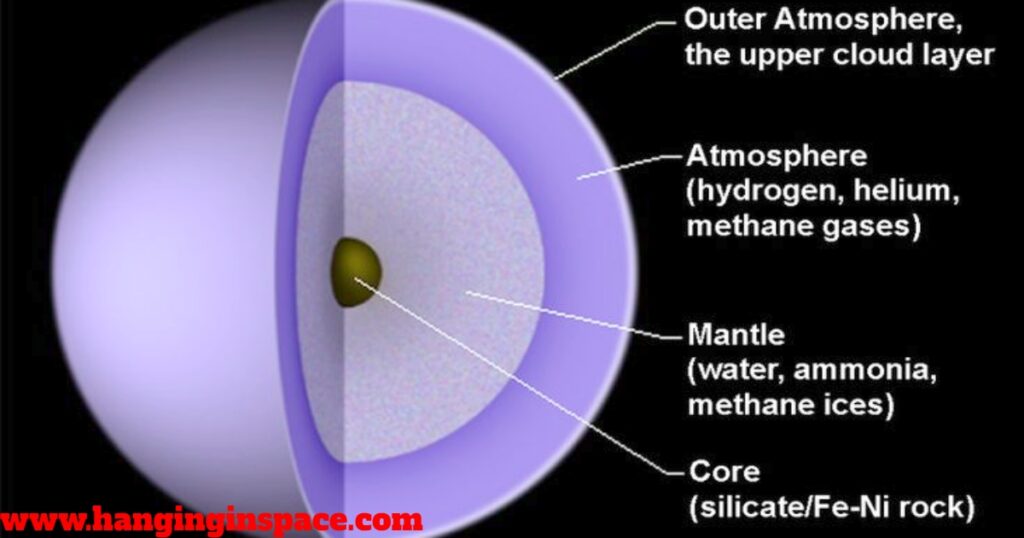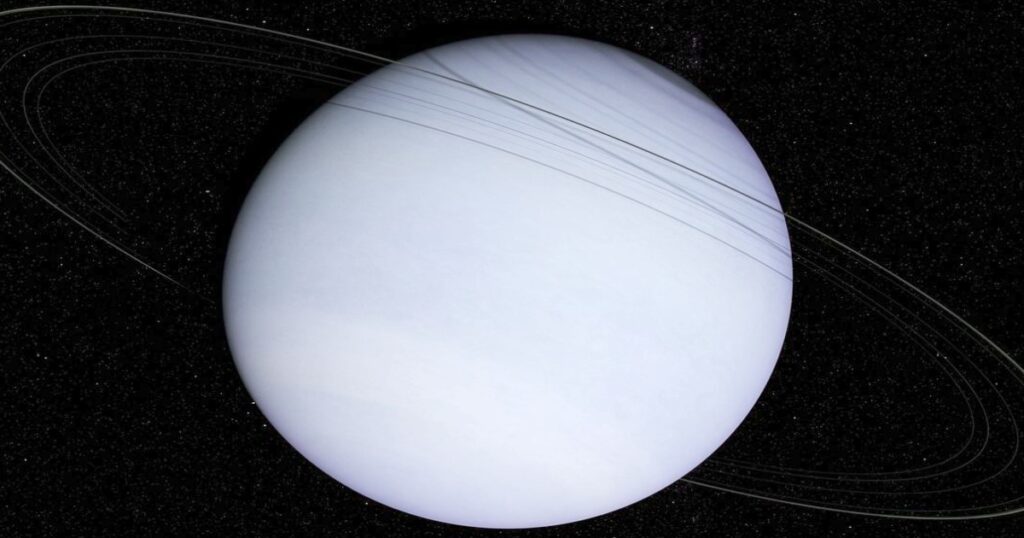Uranus is the third biggest planet in our solar system and is the seventh planet from the Sun. Uranus is an ice giant, along with its neighboring planet Neptune. It has a thick atmosphere of hydrogen, helium, and methane wrapped around a core of rock and ice.
It’s known for its distinctive blue color and surprising tilt on its axis, making it spin almost sideways as it orbits the Sun.

What is the Size of Uranus?
Uranus’ radius is 25,362 kilometers (15,759.2 miles). Uranus’ diameter is 50,724 kilometers (31,518.4 miles). Uranus’ circumference is 159,354 kilometers (99,035.1 miles).
What is the Mass and Volume of Uranus?
Uranus has a mass of approximately 8.68 × 10^25 kilograms and a volume of approximately 6.83 × 10^13 cubic kilometers.
What is the Temperature of Uranus?
The temperature of Uranus is approximately -224 degrees Celsius (-371 degrees Fahrenheit). Uranus is characterized by extremely cold temperatures due to its considerable distance from the Sun and its thick atmosphere composed primarily of hydrogen, helium, and methane.
What is Uranus’ Average Distance from the Sun & Earth?
The average distance between Uranus and the Sun, known as its semi-major axis, is approximately 2.88 billion kilometers (1.79 billion miles).
The average distance between Uranus and Earth varies depending on the positions of the two planets in their orbits, but it ranges from about 2.6 billion kilometers (1.6 billion miles) to 3.2 billion kilometers (2 billion miles).
How long does it take Uranus to Orbit the Sun?
It takes Uranus 84 Earth years to complete one full orbit around the Sun.
How long does it take Uranus to Spin on its Axis?
It takes Uranus about 17 hours and 14 minutes to complete one full rotation on its axis. Uranus is tilted nearly sideways on its axis, spinning like a rolling ball instead of upright like most planets.
Gravitational Field Strength:
The surface gravity of Uranus is approximately 8.69 m/s² (meters per second squared). This is about 89% of Earth’s surface gravity (which is 9.81 m/s²).
Escape Velocity:
The escape velocity to leave the gravitational pull of Uranus is approximately 21.3 kilometers per second (km/s).
Moons of Uranus:
Uranus has a total of 27 known moons. These moons are divided into five major groups based on their characteristics and orbits:
Inner Moons:
The innermost moons of Uranus, also known as the Uranian moons, are relatively small and closely orbit the planet. The five inner moons are Miranda, Ariel, Umbriel, Titania & Oberon.
Major Moons:
The major moons of Uranus are larger and more distant from the planet compared to the inner moons. The two major moons are Miranda & Ariel.
Medium-Sized Moons:
Uranus has a group of medium-sized moons that orbit at greater distances from the planet. These moons include Umbriel, Titania & Oberon.
Small Moons:
Uranus has several small moons that are irregularly shaped and orbit at varying distances from the planet. Some of these small moons include Cordelia, Ophelia, Bianca, Cressida, Desdemona, Juliet, Portia & Rosalind.
Irregular Moons:
Uranus also has a group of irregular moons that have highly eccentric orbits and are believed to be captured asteroids or Kuiper Belt objects. Some of these irregular moons include Caliban, Sycorax, Prospero & Setebos.
What is the Composition of Uranus?
Uranus is classified as an ice giant, along with its neighboring planet Neptune. Despite its name, Uranus is not primarily composed of gas but rather a mixture of gas and icy materials.
The atmosphere of Uranus consists mainly of hydrogen and helium, similar to Jupiter and Saturn, but it also contains traces of methane, which give the planet its distinctive blue-green hue. Beneath its thick atmosphere lies a layer of icy materials, including water, ammonia, and methane, surrounding a rocky core.
What is the Interior Structure of Uranus?
While directly observing the interior structure of Uranus is impossible with current technology, scientists rely on various methods to create a convincing view. One approach involves studying the planet’s gravitational field and rotation. These factors provide clues about the distribution of mass within Uranus.
Another method involves analyzing the data collected from distant observations and spacecraft flybys. By studying the way Uranus reflects and absorbs light, astronomers can determine the composition of its interior layers. Based on these combined efforts, the theory suggests a three-layered structure for Uranus:
Rocky Core:
At the heart of Uranus lies a dense, rocky core, likely composed of iron and nickel. Estimates suggest this core could be roughly the size of Earth, containing a significant portion of the planet’s total mass.
Icy Mantle:
Enveloping the rocky core is a thick mantle of icy materials. This layer is believed to be a hot, dense fluid, composed primarily of water, ammonia, and methane in a supercritical state, a state where the distinction between liquid and gas blurs due to extreme pressure and temperature. This icy mantle is thought to make up the bulk of Uranus’s mass.
Hydrogen-Helium Atmosphere:
The outermost layer is the familiar hydrogen-helium atmosphere we observe through telescopes. However, unlike Jupiter and Saturn, where these light elements dominate, they are present in a much smaller proportion on Uranus.

What does the Atmosphere of Uranus consist of?
The atmospheric composition of Uranus is roughly 83% hydrogen, 15% helium, and 2% methane, with trace amounts of water vapor and ammonia. Interestingly, despite the abundance of hydrogen, it doesn’t dominate Uranus’s atmosphere as it does in Jupiter and Saturn. Some scientists believe it rains diamonds on Uranus and Neptune.
What are the Layers of Uranus’ Atmosphere?
Thermosphere:
The outermost layer, directly exposed to the Sun’s brutal radiation, leading to extremely high temperatures.
Stratosphere:
Here, methane plays a crucial role, absorbing sunlight and influencing the planet’s overall temperature.
Troposphere:
This is the deepest layer we can observe, likely where weather phenomena like clouds and storms occur. Unlike Jupiter’s Great Red Spot, Uranus exhibits a more subdued atmosphere with subtle cloud features.
What is Uranus’ Magnetosphere?
Uranus has a unique magnetosphere that is tilted at a significant angle relative to its rotation axis. It is weaker than those of Jupiter and Saturn but still extends far into space, protecting the planet’s atmosphere from the solar wind.

What is the Uniqueness of Uranus?
Several aspects of Uranus set it apart from its giant planet companions:
Axial Tilt:
Most planets in our solar system have a relatively upright tilt on their axis. However, Uranus boasts a dramatic axial tilt of nearly 90 degrees, causing it to spin almost on its side like a rolling ball. This peculiar tilt has a significant impact on the planet’s seasons and weather patterns.
Internal Heat Source:
Unlike Jupiter and Saturn, which radiate more heat than they receive from the Sun, Uranus seems to have a weaker internal heat source. The source of this internal heat remains an ongoing mystery, with some theories suggesting it might be linked to the conversion of ice under high pressure within the mantle.
Faint Rings:
Unlike the prominent ring systems of Jupiter and Saturn, Uranus possesses a much fainter and less extensive ring system. These rings are composed of dark, dusty particles, making them challenging to observe from Earth.
Uranus’ Formation:
Uranus is believed to have formed around 4.5 billion years ago, during the early stages of the solar system’s formation. It is thought to have originated from the same protoplanetary disk of gas and dust that gave rise to the Sun and other planets.
The formation of Uranus likely involved a process known as accretion, where small particles collided and gradually merged to form larger objects, eventually coalescing into a protoplanet.
As Uranus grew in size, its gravity attracted more material, including gases and ice, contributing to the formation of its atmosphere and icy mantle. One of the distinguishing features of Uranus is its extreme tilt, where its rotational axis is nearly parallel to its orbital plane.
This unique orientation suggests that Uranus may have experienced a violent collision with a massive object during its early history, leading to its peculiar tilt. Despite ongoing research and exploration, many aspects of Uranus’ formation and early history remain uncertain. Further study of the planet’s composition, structure, and geological features is essential to unraveling the mysteries of its origins and evolution.
When and Who Discovered Uranus?
Uranus, the seventh planet from the Sun, was discovered by the British astronomer William Herschel on March 13, 1781. While surveying the night sky using a homemade telescope, Herschel observed a faint object that appeared to move against the backdrop of stars. Initially, he thought it was a comet, but further observations revealed that it was a new planet.
Herschel named the planet “Georgium Sidus” (George’s Star) in honor of King George III of England, but it was later renamed Uranus, after the ancient Greek god of the sky, to conform with other planetary names. The discovery of Uranus marked the first new planet to be identified in recorded history and expanded our understanding of the solar system’s boundaries.
Uranus Exploration:
While Uranus has been visited by only one spacecraft, Voyager 2, in 1986, there is growing interest in exploring the planet further. Proposed missions, such as NASA’s Uranus Orbiter and Probe, aim to study Uranus’ atmosphere, magnetosphere, and interior in greater detail.
These missions promise to unlock new insights into the mysteries of Uranus and deepen our understanding of the outer solar system.
Uranus as compared to Neptune:
Uranus Vs. Neptune
| Feature | Uranus | Neptune |
|---|---|---|
| Type | Ice Giant/Gas Giant | Ice Giant/Gas Giant |
| Average Distance from the Sun (AU) | 19.2 | 30.1 |
| Diameter | 51,118 km (4 times Earth’s diameter) | 49,528 km (3.9 times Earth’s diameter) |
| Volume | 63 Earths | 58 Earths |
| Mass | 8.68 x 10^25 kg (14 times Earth’s mass) | 1.024 x 10^26 kg (17 times Earth’s mass) |
| Density | 1.27 g/cm³ | 1.64 g/cm³ (denser due to higher core mass) |
| Atmosphere | Primarily Hydrogen (H2), Helium (He), with trace amounts of Methane (CH4), Ammonia (NH3), Water (H2O), and Hydrogen Sulfide (H2S) | Primarily Hydrogen (H2), Helium (He), with trace amounts of Methane (CH4), Ammonia (NH3), Water (H2O), and traces of higher hydrocarbons |
| Rings | Fainter ring system composed primarily of dark, dusty particles with some larger icy moons embedded | Fainter ring system composed of dark, dusty particles with some embedded arcs of brighter material |
| Great Red Spot | No prominent persistent storm system | Great Dark Spot, a large anticyclonic storm system |
| Axial Tilt | 97.8° (nearly sideways) | 28.3° |
| Moons | 27 known moons (as of October 2023) | 14 known moons (as of October 2023) |
| Internal Structure | Metallic hydrogen and helium core, surrounded by icy mantle and a hydrogen-helium atmosphere | Metallic hydrogen and helium core, surrounded by icy mantle and a hydrogen-helium atmosphere, with possible additional differentiation within the icy mantle |
Conclusion:
By investigating Uranus’ composition and exploring its hidden interior, scientists hope to uncover the secrets of this distant ice giant and shed light on its place in the cosmic tapestry of the universe.
